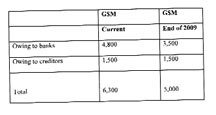Dear Editor,
The Guyana Sugar Corporation Inc. is extremely disturbed by efforts of the Guyana Agricultural and General Workers Union to distort the grim realities which confront the sugar Industry.
GAWU issued a letter to the media (SN October 29, 2009) using information in relation to the operations of GuySuCo in a most erroneous manner and which sends a message which could not be further from the truth. It plays upon the past in a manner which is full of inaccuracies and which could derail plans to return the industry to viability.
Yesterday was the final conciliation meeting, where a deadlock was declared and the Company expressed a desire to go to arbitration. Within this context the 3% increase which was on the table was withdrawn.
GAWU in a press release yesterday afternoon again presented the Company’s position out of context.
Additionally, workers yesterday again resorted to strike action in contravention of the collective bargaining agreement.
Such actions are frustrating GuySuCo’s turnaround plans the implementation of which has commenced.
We seriously question the purpose of the letter. We fail to see how the letter and yesterday’s strike action could help the cause of our workers when the company cannot even afford the 3% increase it had on the table.
Response to GAWU letter
Earnings, Production- And Implications
In the letter in yesterday’s Stabroek News headlined `Sugar industry not growing the requisite quantity and quality of canes to utilize its productive capabilities’, the revenue figures are stated in gross terms and do not take account of the freight costs which is required to get the product to the customer and which is a component of the price that is received for sugar sold under the European Union arrangement. Freight costs are very significant and generally increase or decrease in line with global economic conditions. In 2006, the Corporation’s freight costs averaged US$58 per tonne sugar shipped (8% of the selling price) while in 2008 freight costs to Europe averaged US$114 per tonne sugar shipped (18% of the selling price) which is almost a 100% increase. The total freight costs in 2006 were G$2,585M and in 2008 were G$3,563M (an increase of $1,000M) with 180,649 tonnes and 185,649 tonnes sugar shipped respectively. If one was to compare revenues it must be done by comparing net revenues year on year as this gives a much better picture of what was earned by the Corporation.
Net Revenues (after deducting freight costs)

When freight costs are taken into account, revenues have actually declined between 2006 and 2008 notwithstanding the increase in the euro rate against the US$.
A major contributor to the loss in 2008 was the enormous increase in input prices brought on by events occurring in the wider economic world. Countries all over the globe saw substantial increases in the price of raw materials and Guysuco was no exception, as some of the prices of our key inputs i.e fertilizers and fuel increased threefold. The substantial price increases in fuel and fertilizer alone resulted in the Corporation expending almost $3,000M more than the previous year and this was for only these items.
Employment Costs
GAWU refers to employment costs increasing by a mere 6.4% when there is a compounded wage increase of 34.4%. The sugar production numbers from 2004 to 2008 are also quoted as declining from 325,317 tonnes sugar in 2004 to 226,267 tonnes sugar in 2008.
A fundamental principle in Guysuco’s cost structure is that a substantial portion of employment costs vary with activity levels. Those activities include:
Cane Production
Sugar Production
Land Preparation
Planting.
With declining cane and sugar production, land preparation and planting activities due largely to the adverse weather conditions experienced in those years, employment costs would not keep pace with the compounded increase in wages over the period. Notwithstanding that, in 2004 employment costs per tonne sugar produced was $50,412 as against 2008 when it was $77,342. This is a 54% increase in employment cost per tonne sugar in 2008 when activity levels were significantly lower. The increase in real wages therefore is far more than the 34.4% compounded wage increase and the aggregate inflation rate over the period.
Employment cost per tonne sugar
If the percentage wage increase from 2005-2008 was applied to the employment cost per tonne sugar of $50,412 (in 2004), then employment cost per tonne sugar produced in 2008 should be $64,225 and the total wage bill should have been $14.5Bn and not the $17.5Bn actually paid. It means the Corporation has paid out over $3Bn more in employment costs which indicates reduced productivity.
Cost of every 1% wage increase
A cost of $150M is quoted as the increase in employment costs for every 1% wage increase and writer is saying this is baseless. Employment costs in the five years 2004-2008 averaged $16.5Bn (as set out in the table). A simple calculation of one percent of $16.5Bn is $165M, so it is very difficult to determine why the additional cost of $150M is baseless. One can say it is under estimated.
Financial Realities
2009
The Corporation currently owes the banks a total of G$4,800M with $3,200M owing to a consortium of local banks and $1,600M owing to ING bank of Holland. The amount owing to ING has to be repaid by 31st December 2009. A total amount of G$1,500M is owing to creditors with the average age of creditors at 60 days.
Based on a production of 242,000 tonnes sugar in 2009, the Corporation is expected to end the year with a cash deficit of $3,400M, but any further decline in production would see an increase in the deficit. The amount owing to creditors at the year end is expected to be of a similar amount as that prevailing now.
The amount expected to be expended on employment costs for the year is $15,500M.
A loss of $2,600M is expected this year.
Summary of debts to banks and creditors:

Projections for 2010
The budget for 2010 anticipates a production of 280,000 tonnes sugar with a 5% increase in land preparation and planting activities from the 20% level that is normal.
The projected cash deficit at the end of 2009 is expected to be $523M if the sale of the Diamond lands of $10.6Bn is to be included as cash proceeds. If the proceeds are not included then the cash deficit is expected to be $11.2Bn.
Included in the budget is capital expenditure of $8.7Bn which requires funding from Guysuco’s cash generated whether from land sales or normal operating cash flows.
The plan is to continue to utilize the overdraft facility of $3,200M from the local banks and also borrow $3,400M from an international bank to fund the working capital requirement. This implies that the Corporation will require $6,400M from banks in 2010 for short term working capital which is in addition to our normal amounts of $1,500M to $2,000M owing to creditors. If the sale of the Diamond lands fails to materialize then the borrowings will be considerably greater, assuming lenders could be found.
The total employment cost for the year is expected to be $16,500M.
If land sales do not materialize, a loss $4,900M is projected.
Conclusion
Does the sugar industry die now! Does it die painfully in three years! Or do we confront the realities together and work to ensure the successful implementation of the turnaround plan.
Yours faithfully,
Errol O S Hanoman
Chief Executive Officer







